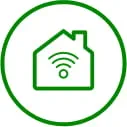Welcome to the world of fiber-optic internet. If you’ve been hearing all the buzz about fiber and wondering what it’s all about, you’ve come to the right place. Let's dive into what you need to get started with fiber-optic internet and why it's hands down the best connection available. But before we do, it’s helpful to understand just how special fiber internet is.
The magic behind fiber-optic internet
Imagine a very thin, flexible strand of glass or plastic—about the thickness of a human hair. This is the core of a fiber-optic cable. These tiny fibers are bundled together in cables that can carry massive amounts of data at incredible speeds. Here’s where the magic happens. Traditional cables use electrical signals to transmit data, but fiber-optic cables use light. Yes, light. Here’s a simple breakdown:
- Light pulses: Data is sent as pulses of light, kind of like Morse code but way faster and using light instead of sound.
- Total internal reflection: The light pulses travel through the core of the fiber-optic cable by bouncing off the walls of the core in a zigzag pattern. This is called total internal reflection, and it keeps the light inside the core, even if the cable bends or twists.
- Transmission: These light pulses carry the data from one end of the fiber-optic cable to the other. At the receiving end, these light signals are converted back into the data that our devices understand—like text, videos and music.
Light is incredibly fast—nothing in the universe travels faster. This means data sent via light can move at speeds close to the speed of light, which is about 186,000 miles per second.
Here’s why using light makes fiber-optic cables so effective:
- High bandwidth: Fiber-optic cables can carry a lot more data at once compared to traditional copper cables. Imagine a superhighway with 1,000 lanes versus a single-lane road.
- Low signal loss: Over long distances, traditional cables lose signal strength. Light signals in fiber-optic cables experience much less loss, meaning they can travel longer distances without needing a boost.
- No interference: Light signals are immune to electromagnetic interference from things like radios, motors and other electronic devices. This means a cleaner, more reliable connection.
- Future-proof technology: Fiber-optic infrastructure is built to handle increasing data demands, making it a long-term investment in your internet experience.
Think of it like sending a message in a bottle across a river (traditional cables) versus shooting a laser beam (fiber-optic cables) across the same river. The laser beam is faster, more direct and unaffected by obstacles in the water.
What you need for fiber-optic installation
Now that you understand just what makes fiber-optic internet so special, let’s discuss what you’ll need to do to make the switch.
Check availability
First things first, you need to see if fiber-optic internet is available in your area. Like many internet service providers (ISPs), Ziply Fiber offers an online tool to check availability simply by entering your street address.
Choose your plan
Once you’ve confirmed that fiber is available, it’s time to choose a plan. Think about your internet usage: Do you stream a lot of HD or 4K videos? Are there multiple people in your household using the internet at the same time? Does anyone in your home work remotely? Ziply Fiber offers a range of plans to suit different needs and budgets.
Schedule installation
After selecting your plan, you’ll need to schedule an installation appointment. Here’s a quick rundown of what to expect during the installation process:
- Outside installation: The technician will run fiber-optic cables from the nearest utility pole or underground line to your home.
- Inside installation: The technician will install an Optical Network Terminal (ONT) inside your home. This device converts the light signals into data that your devices can use.
- WiFi router setup: Most ISPs provide a WiFi router that connects to the ONT, giving you wireless access throughout your home. If you have your own router, the technician can help you set it up.
Switching to fiber-optic internet is like upgrading from a dial-up modem to a jet engine. The installation process is straightforward, and the benefits are unbeatable. So, if you’re ready for lightning-fast speeds, rock-solid reliability and a connection that’s built for the future, fiber-optic internet is the way to go.






